By Kent Paterson
In Mexico, September boasts many historic dates with reverberations that continue shaping the nation today. Besides the official Independence Day holiday of September 16, numerous keystone events have occurred in the month when summer transitions into fall.
The Mexican Presidency
September 30 marks Mexican President Andrés Manuel López Obrador’s last full day in office before handing over the reins of power to Claudia Sheinbaum Pardo, the first woman ever elected president in Mexico.
“I dedicated myself to serving the people and I did it with a lot of love…,” López Obrador (AMLO) said at one of his last early bird press conferences that became a morning ritual during the past five years and 10 months.
“We are coming along well in the process of change, in the process of transformation, and we must continue in this way because the economy is good, there is well-being, and because we have advanced in guaranteeing peace and tranquility…”
AMLO’s parting words will surely be grist for the debate mill, but a review of his administration is far beyond the scope of this article. Suffice it to say that the 71-year-old leader concludes his term with record popularity and leaves behind a left-leaning political program, the Fourth Transformation (4T), which incoming President Sheinbaum of AMLO’s Morena party pledges to not only continue but take to a higher level.
Other consequential dates in September worth noting (this is far from a complete run-down) include September 29, National Corn Day, and September 30, the birth of Independence War hero José María Morelos y Pavón.
September 19 is the day deadly earthquakes struck Mexico City in 1985 and 2017, with the first disaster claiming thousands of lives but widely credited for eroding the prestige and power of the long-ruling Institutional Revolutionary Party (PRI).
Especially in an era of human-induced climate change, it would be remiss to omit that September is hurricane season in the Aztec Republic, as was dramatically illustrated this past week when Hurricane John slammed Acapulco and other Pacific coastal zones of Oaxaca, Guerrero and Michoacán, uprooting crops flooding neighborhoods, triggering mudslides, cutting off highways, isolating rural towns, and temporarily shutting down Acapulco’s international airport. As is typical in such catastrophes, the early tally of mortal victims account ranged wildly, from the eight persons mentioned by AMLO to 22 reported by Aristeguinoticias.
Hurricane John hit shore less than one year after Category Five Hurricane Otis devastated the fabled city on Santa Lucia Bay, which still had a long ways to go in recovering from Otis’ rampage. Scarce stories in Mexican press reports on John mention Otis. Recovering from John will practically be the first order of business of new President Sheinbaum, who announced a high-level meeting on the emergency for the second day she’s in office.
Meanwhile, more heavy rains are predicted along the Mexican Pacific.
Iguala and Ayotzinapa Ten Years Later
In Mexico, September 26-27, 2014 is now remembered as a long night of terror and infamy, when security forces in the city of Iguala, Guerrero, killed three students from the rural male teachers college of Ayotzinapa, three other civilians, wounded 40 others (including one student who survives in a coma to this day) and forcibly disappeared 43 Ayotzinapa pupils. The remains of three of the disappeared students were later identified, but the whereabouts of 40 others are still unknown to this day.
The violence has been traced to as many as five municipal police departments working in cahoots with gunmen linked to a Guerrero narco organization. Guerrero state police, federal police and military personnel have also been implicated in the carnage, which ironically began when Ayotzinapa students attempted to commandeer commercial buses so they could attend the annual protest/memorial in Mexico City in commemoration of the October 2 anniversary massacre of pro-democracy Mexican students by soldiers in 1968.
Investigations by an independent commission of international experts as well as some journalists and Mexican authorities indicate the violent attack might have been unleashed when students unknowingly seized a bus used to transport drugs and/or money to the U.S.
The Night of Iguala unleashed a storm of protest against President Enrique Peña Nieto’s government, drawing tens of thousands into the streets in Mexico and other nations, including Ciudad Juárez, El Paso, Las Cruces and Albuquerque. The number 43 and the words “They were taken alive, We want them back alive”, riveted the globe.
Since then, the Ayotzinapa justice movement has largely subsided outside Mexico, where it remains an unresolved, burning issue with critical questions unanswered. What was the precise motive in the vicious aggression against the students? Who called the shots behind the scene? And, most importantly, what happened to the missing students?
AMLO came into office in late 2018 promising to get to the bottom of the matter and secure justice. An Aytozinapa Truth Commission (Covaj) was established, scores of suspects charged in connection with the case (including two senior army officers) and Peña Nieto’s attorney general jailed.
After 2022, the progress began unraveling, punctuated by conflicts between AMLO and some parents of the missing students and their lawyers, the languishing or reversal of legal cases, and disputed accusations that the Mexican army, which is defended by AMLO, is blocking access to critical files.
Tomás Zerón, a high-ranking former Peña Nieto security official wanted in the case fled to Israel. An extradition request from the Mexican government has been unmet by Tel Aviv.
AMLO ended his presidency with this take on the status of the Ayotzinapa case: “…We did everything to find the young men and nobody was protected. We wanted to know everything, but things got complicated and entangled, complicated by interests, but the truth always comes and justice comes late, but it comes … .”
Quoted on Desinformemenos.org, Hilda Legideño, mother of disappeared student José Antonio Tizapa, contended that AMLO “betrayed the trust we put in him as parents and turned his back on the Aytozinapa case to protect the army…these are ten years we’ve come in spite of everything-the pain, sickness and weather. We will continue.”
For his part, Alejandro Encinas, the former mayor of Mexico City and chief of Covaj who left the post in 2023, told Mexican journalist Blanche Petriche that finding more remains would be difficult because of the passage of so much time and the potential for physical degradation from weather and climatic conditions and scavengers.
One point in common among AMLO, Encinas and the Ayotzinapa justice movement is that a pact of silence prevails among the perpetrators of a crime against humanity. The question is: Who is responsible for the cover-up?
Scantily covered by the international media, the 10th anniversary of Iguala/Ayotzinapa was a leading story in the Mexican press as September wound down. In Mexico City thousands marched in remembrance of the Ayotzinapa students and demanded justice.
Demonstrations were likewise staged in Cuernavaca, Aguascalientes, Chihuahua City and Ciudad Juárez, among other places. The Ayotzinapa students who participated in this year’s anniversary protests were young children when the atrocity occurred. Ten years later, the truth behind the barbaric night appears elusive as ever, and dozens of families are submerged in seemingly perpetual anguish over the fates of their loved ones.
Incoming President Claudia Sheinbaum vows the case of Ayotzinapa will not be closed. She will be the third president to handle the matter. Stay tuned.
Debts from the Dirty War
The Iguala/Ayotzinapa atrocity harkened back to the days of repressive PRI rule, especially during an era marked by guerrilla uprisings and violent counterinsurgency campaigns broadly known as the Dirty War. The Dirty War has been the subject of four separate official probes, most recently the voluminous report issued by the Truth Commission established during the first year of AMLO’s administration and sent to the departing president this month.
Covering the years from 1965 to 1990, the Truth Commission’s report confirmed information that was previously discussed in other investigations, but added important details and names to the historical record. In addition to the guerrilla-government conflict, the investigators expanded the scope to include government human rights violations committed against unarmed social movements, dissidents of various stripes and socially scorned sectors of the population such as gays and sex workers.
Differing from the earlier investigations, the latest Truth Commission documented far more victims-more than 8,000 people- who suffered extrajudicial executions, arbitrary arrests, torture, forced disappearance and other human rights violations. Of the victims, 1,103 were forcibly disappeared between 1965 and 1990. Like the Ayotzinapa justice movement, relatives of the victims of forced disappearance by government security forces demand to know what happened to their loved ones.
In the historical period examined by the investigators, a seminal date of importance was September 23, 1965. On that day, 13 poorly armed men attacked the Mexican army base in the mountain town of Madera, Chihuahua. Eight of the attackers from the Grupo Popular Guerrillero(GPC), the Popular Guerrilla Group, and six Mexican soldiers were killed.
Led by school teacher Arturo Gámiz and Dr. Pablo Gómez (both of whom were slain in the guerrilla assault), the uprising grew out of the mass small farmer movements for land reform in Chihuahua and political change in Mexico which had been violently repressed.
Chihuahua Governor Práxedes Giner gained notoriety for his comment on the September 23 battle, when authorities crudely dumped the slain rebels in a common grave and Giner remarked, “They wanted land so give them more than they can swallow.”
Yet September 23 stirred a sector of Mexican youth. Viewing the triumph of the Cuban Revolution and convinced that all avenues of peaceful change in Mexico were sealed as tight as a mummy’s tomb, thousands formed clandestine guerrilla organizations that operated from Chihuahua in the north to Chiapas in the south and places in between.
Lately, the era has been defined by movement survivors and academics as the time of the Armed Socialist Movement that sought to overthrow the PRI and thoroughly transform Mexico.
Well into the 1970s and early 1980s, a low-intensity conflict of sorts rippled across the Mexican Republic. Taking the offensive, armed groups robbed banks and kidnapped the well-to-do to finance the revolution or to force the release of prisoners, ambushed police and soldiers, bombed government and corporate buildings, staged jail breaks and even kidnapped the U.S. consul in Guadalajara in 1973. Involving perhaps thousands of people, a near-insurrection in Sinaloa erupted in early 1974.
Counterattacking, the Mexican State massively tortured suspects, threatened or incarcerated family members, carried out extrajudicial killings, waged war against entire villages in Guerrero state, and allegedly disposed of the bodies of captured and executed guerrillas and others by dumping them from an airplane into the Pacific Ocean.
Portrayed as ruffians, thieves and terrorists in the press of the time, the guerrillas were young men and women studying to become doctors and teachers and engineers or small farmers wanting a piece of land to work for a decent living. Some were already parents who left behind orphans. Idealistic and internationalist, they were certainly in the pool of potential national leaders.
Armed revolution in Mexico, however, was not to be, and the State crushed virtually all of the guerrilla focos, killing and/or disappearing many revolutionaries and scattering the survivors.
Some movement survivors helped found the center-left PRD party, the predecessor of today’s governing Morena party, while others shied away from electoral politics but participated in myriad social movements.
Ciudad Juárez and Chihuahua were a vital part of this saga. For decades, the story of September 23 and the subsequent movements it helped spark were officially suppressed or stored away in the memories of survivors and loved ones. But that is now changing.
For the first time, the September 23 assault was officially commemorated this year by the new municipal government of Madera, which is now governed by members of the Morena party and influenced by teachers who’ve been active in a variety of non-violent social movements, including the recent successful struggle to overturn conservative Chihuahua Governor Maru Campos’ effort to block national textbooks from entering the state’s schools.
According to Mexican press accounts, September 23 commemorations were also held in the state capital of Chihuahua, where female students from the Saucillo Rural Teachers College reenacted the September 23 assault in a street theater performance staged outside state government headquarters.
“They are combatants against for human rights and against repression,” La Jornada columnist Victor Quintana wrote of today’s heirs of Madera. “They formed left parties, social organizations, feminist collectives….Governor Giner couldn’t imagine that the soil he ordered tossed (on slain rebels) was so fertile.”
September 23 was also commemorated in Ciudad Juárez by activists who draped banners in front of the Benito Juárez Monument and held a tribute to Alberto “Beto” Domínguez, one of the guerrilla fighters who followed in the footsteps of Arturo Gámiz and his comrades.
Beto’s friend, left scholar and activist Gero Fong, stood in front of the monument explaining the historical context of the city and state, the back story of the monument and the significance of September 23, all of which form a certain continuity of rebellion and resistance extending from 19th century President Benito Juárez’s refuge in then Paso del Norte in resistance to French invaders to contemporary times.
“Chihuahua has always been part of the revolutionary struggles of Mexico. It was the backbone of Francisco Villa’s Division del Norte. Later, on the assault on the Madera army base,” Fong elaborated. “Chihuahua has always been in the people’s struggle for the emancipation of Mexico…I sometimes talk to young people who don’t know that Chihuahua was fundamental for the Mexican Revolution. The historians are clear that the principal battles of the Mexican Revolution happened in Chihuahua, the first one which was the Battle of Juárez, when Porfirio Diaz resigned.”
Beto’s Gambit
Beto was one of five Domínguez brothers from Ciudad Juárez who joined the armed underground. He and his brother José were the only two who survived the Dirty War. Like his brothers and other young people of their generation, Beto was drawn into activism by the ’68 student movement. At first participating in aboveground activism, Beto was compelled by the repressive conditions of the time to enlist in a clandestine organization which became known as the Lacandones.
If it’s said cats have nine lives, then Beto had 10, according to a biography distributed at Beto’s tribute.
Detained in 1972 in police raids against suspected Lacandones in Mexico City, Beto spent about one year in Mexico City’s notorious Lecumberri prison, experiencing the torture meted out by jailers. Released in late 1973, he quickly enlisted in the new September 23 Communist League, formed by a fusion of the Lacandones with several other groups.
In his training, he suffered a serious a rock-climbing fall that could’ve killed him. During the next few years, he engaged in combat with the Mexican army in Guerrero, narrowly escaped arrest again at least a couple of times, and even had to quickly ditch a movie premier in Mexico City, when by coincidence, Mexican President Luis Echeverría had the same idea and arrived at the theater to accompanied by his security detail to inaugurate the film.
As the 70s advanced, many Dirty War survivors shelved the armed struggle in favor of mass organizing, or as Beto’s bio described it: “go to the masses, join the ranks of the labor movement..”
Accordingly, the lucky young man from Juaritos got welding jobs in Monterrey. One fateful day while he was pushing 30, Beto suffered a work-related accident that almost killed him but, true to his style, beat the prediction of the doctors in the hospital that he’d perish shortly. Beto lived, but he spent the rest of his life in a wheel chair. Of course, the disability didn’t stop a determined survivor.
Back in Ciudad Juárez, Beto, became practically an icon of the independent left, with his stoic presence at seemingly every demonstration in recent years, whether the issue was militarization, war, Cuba solidarity, feminicides, or the disappeared. Gero Fong called Beto’s life perhaps among “the most interesting and productive lives” ever to witness Ciudad Juárez, as the older activist helped unite the frequently fractious left around common goals, served as a bridge between generations, and contributed knowledge and historical memory.
“Beto never abandoned the struggle. After the armed struggle, he continued with the peaceful struggle, supporting practically all the different fronts emerged,” Fong said. “He never abandoned the young people. He always took up new causes he supported, the new movements.”
Beto’s friend Meche recalled meeting him some 30 years during the Zapatista uprising in Chiapas when Juárez activists erected a solidarity encampment in the downtown plaza. The meeting contributed greatly to Meche’s own political development. “He had very high goals, and he helped organize us and know these truths,” she said. “He opened my eyes.” The Juarense characterized Beto as a man who made lasting impressions.
“Anyone who met him had to love him,” she said. “He was a person that even while in a wheel chair for 43 years kept struggling and organizing, searching for his (disappeared) brothers. Because of Beto’s efforts, he found his brother Gabriel, who was dead but it wasn’t known where his remains were at.”
For Gero Fong too, Beto was fountain of inspiration: “We’d look at him and say, ‘If Beto Domínguez Dominguez continues being ready for action in the condition he’s in, there is hope. At certain times, we’d be very alone, down to a handful of activists. And there was Beto. At other times, the movement would be bigger with hundreds of people. And there was Beto. He was always present.”
Perhaps befitting a tumultuously trying but deeply dedicated life, Alberto “Beto” Domínguez passed away on September 16, 2022, the 212th anniversary of the day Padre Miguel Hidalgo rallied an indigenous rebel army and initiated the War of Independence that ultimately led to the founding of the country we know today as Mexico.

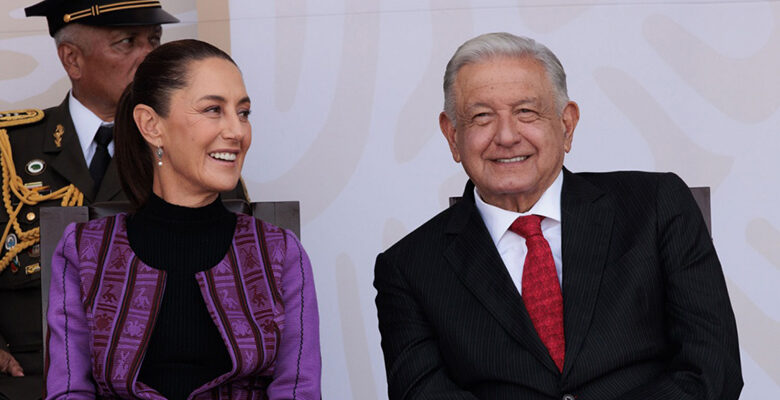
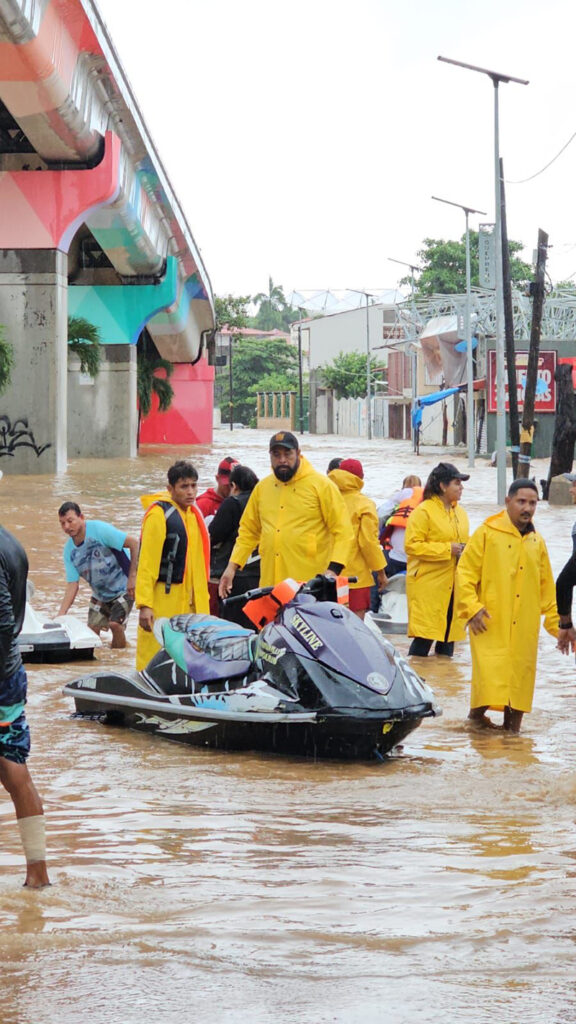
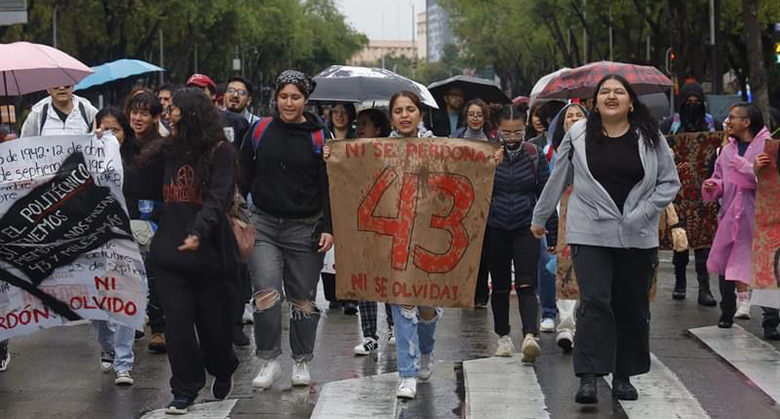
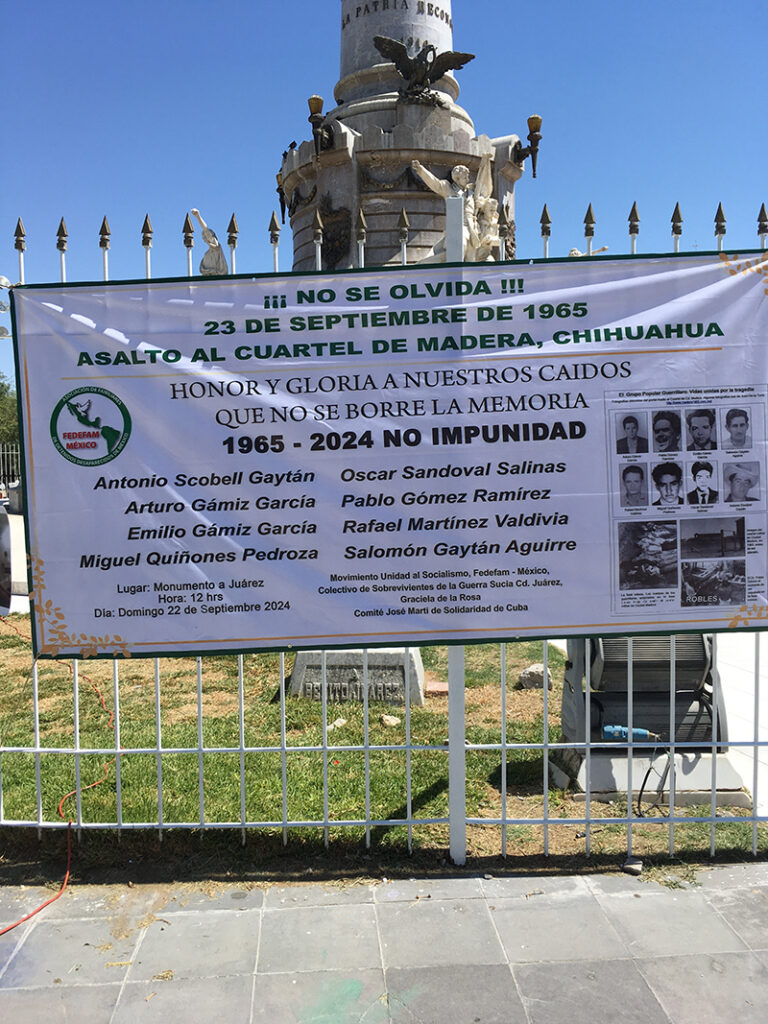
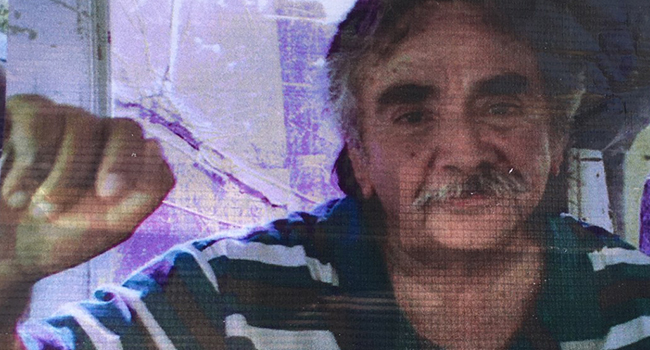
Excellent writing. Thanks for Posting Rich. I’ll never forget AMLO visiting El Chapo’s TWICE in her small village home in Sinaloa….I always wondered what that was about.
Correction: I meant to say “Visiting El Chapos MOTHER,”….As AMLO would say, “Ballazos y No Abrazos.”